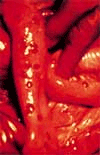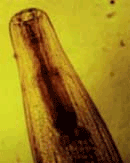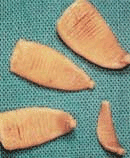![]()
![]()
WHAT IS DEWORMING? Paste dewormers are safe and effective ways of controlling internal parasites and important part of horse ownership. They are available through your local veterinarian, feed stores or order on-line. The dewormer paste comes in a tube which you dose by weight.
WHAT IS A WORMER ROTATION SCHEDULE? Rotation simply means to use a different class of wormer rather than using the same wormer all of the time. Some of the wormers are better at controlling certain internal parasites at certain times of year. This rotation also helps to prevent the parasites from developing a resistance.
WHEN SHOULD YOU DEWORM YOUR MINI? Deworm your horses every 6 to 8 weeks using recommended dewormer rotation schedule for the three classes of dewormer ( fenbendazole, pyrantel and ivermectin ).
HOW MUCH DEWORMER SHOULD YOU USE FOR YOUR MINI?
Adults: 300 pound dose for 34" and under minis,
Foals/Weanlings: 150 pound dose. Read the label on the dewormer, some should not be given to foals younger than 6 months.
HOW DO YOU GIVE A PASTE WORMER TO A MINI? Halter your mini and make sure that your horses mouth is empty: free from grass, hay or grain so the wormer isn't spit out. Administering the dewormer is as easy as turning the dial on the dewormer tube to correspond to your horses weight, insert into the corner of the horses mouth, then, gently depress the tube's plunger. Make sure your mini swallows the dewormer and doesn't spit it out.
Deworm in March/April and September/October with products containing Ivermectin and Praziquantel, "Zimecterin Gold" contains both of these which will kill tape worms in the horses. Another option to control tapeworms is double dose of Pyrantel.
USE OF MOXIDECTIN DEWORMER? I cannot tell you if the stories of bad reactions and fatalities using this wormer with minis are true or not. I am not one for experimentation, so I avoid this product.
Brand names of products indicated in blue below: The schedule below takes into account when certain parasites are likely to be found in the pastures and passed on to your horse through ingestion.
J
anuary/Februaryfenbendazole - a safe and effective wormer paste for the control of large and small strongyles, ascrids & pinworms in horses. Panacur, Anthelcide EQ, Safeguard
March/April
1.87% ivermectin - Paste wormer and boticide that controls bots, ascrids, large and small strongyles, pin, hair, stomach and threadworms. For use in all horses of any age, including pregnant or nursing mares. For safe effective control of 34 species & stages of worms and bots. Foals should be treated initially at 6 - 8 weeks of age and routine treatment repeated as appropriate.
Equimax, Equimectrin, Zimectrin or IVERMECTIN GOLD**May/June
pyrantel pamoate - Removes internal parasites in all types of horses and ponies: large
strongyles (bloodworms), small strongyles, pinworms & roundworms. Horses and ponies (
over 8 months) should be treated every 6 weeks. Mares should be treated 1 month before
foaling and again 10 days after foaling. Foals dose (2-8 months of age) every 4 weeks.
July/August
fenbendazole
September/October
1.87% ivermectin
November/December
pyrantel pamoate
| Type of Worm | Description | ||
Strongyles
|
Large Strongyles Also known as
bloodworms or roundworms. Eggs that are present in manure hatch into
larvae and can be consumed by a grazing horse. The larvae continue to
develop in the intestinal tract. Strongyles will travel through blood
vessels to various organs until they reach the intestine again.
Extensive damage can be caused to the lining of the blood vessels. Small Strongyles Small strongyle larvae lay dormant in the intestinal wall waiting for the right conditions to materialize. When this happens they may become encysted. If this occurs, small strongyle larvae are not vulnerable to most dewormers. Severe damage may be caused to the intestinal wall if large amounts of small strongyle emerge simultaneously. Diarrhea and colic may be apparent. Wright loss, poor coat condition, slowed growth and loss of condition are other signs of small strongyle infection. |
||
|
|
|||
|
Ascarids
|
Ascarids are also called large roundworms. These parasites are found more often in young horses than older horses. They can grow to 12 inches long and can be found in the hundreds in the small intestine. This can lead to poor nutrition. Common signs of ascarid infestation is coughing, colic and diarrhea. They can cause blockage or even travel through the horse’s lungs causing pneumonia. Ascarid eggs are acquired through feces from other horses which can be found in contaminated hay or water. Once the eggs hatch in the intestinal tract, the worms push through the intestinal wall. It usually takes about a week for the worms to reach the lungs. After leaving the lungs, ascarids continue to travel to the horse’s mouth to be swallowed again. They reach full maturity in approximately 2 to 3 months. At this time the parasites lay eggs that are passed in the feces and the cycle begins again. |
||
|
|
|||
|
Pinworms
|
Pinworms are less dangerous to a horse’s health but are still annoying. They cause severe anal itching which causes the horse to rub its tail and the anal region creating bare patches and sometimes injury around the tail and broken tail hairs. Pinworms can be acquired by drinking contaminated water or eating infested hay, grain or grass. Maturity is reached within 3 to 4 months. Pinworms then crawl part of the way out of the anus and lay eggs on an outside surface. After the eggs hatch outside of the horse’s body, the parasites become infective within 72 hours. However, they can stay alive unhatched for a few months. |
||
|
|
|||
|
Tapeworms
|
Tapeworms are spread through mites that can be found on plants located in a grazing pasture. The mites consume the eggs found in an infected horse’s manure. Grazing horses can swallow the mites and become infected. This infection can lead to colic, digestive problems and even malnourishment. It is estimated that approximately 40% of the horses living in the United States are affected. |
||
|
|
|||
|
Bots
|
Bots are the immature larvae of the botfly, which resembles the honeybee in appearance. Because of the widespread presence in a horse’s environment, most horses will become infected. These parasites are most commonly found in the early fall and late summer. Adult female botflies lay eggs on the horse’s hair by attaching themselves to the nose, throat, forelegs or chest. As a horse licks itself, the larvae attach themselves to the gums, cheeks and tongue. After 3-4 weeks, the bot larvae travel to the stomach and attach to the lining where they will remain for several months causing irritation, blocking the opening to the small intestine and interfering with digestion. After 8-10 months have passed, the parasite is passed through feces and the process starts again. |
||





